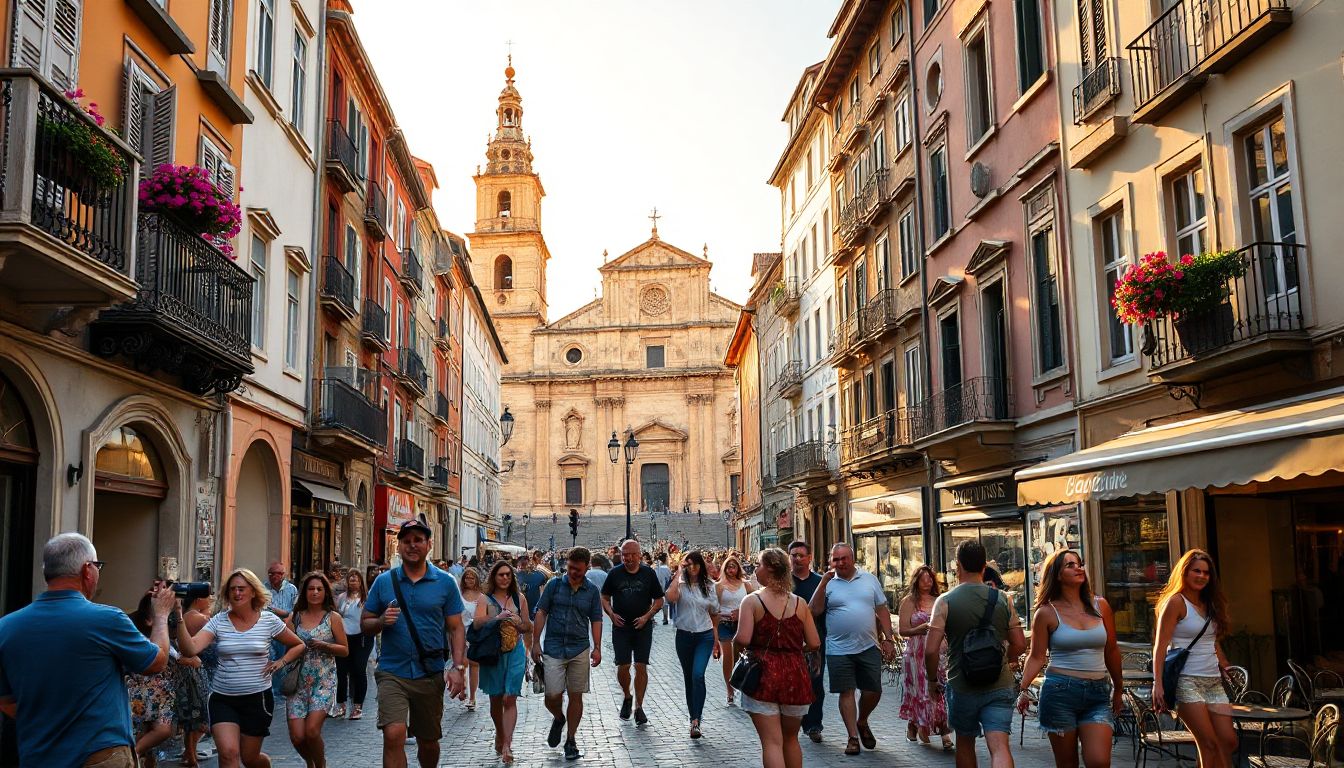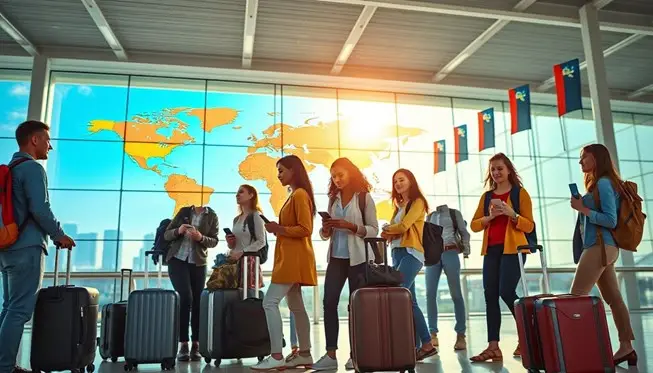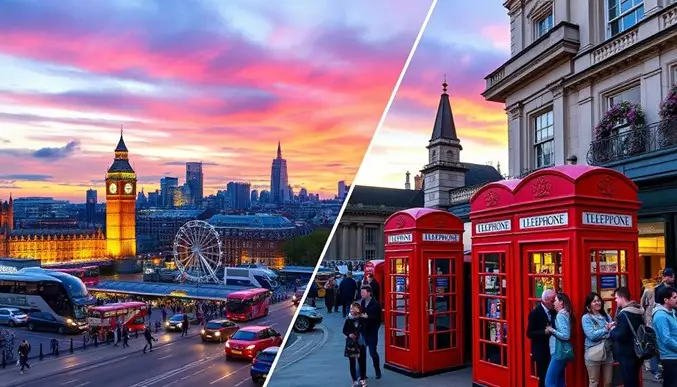Introduction
Travel and tourism are more than just visiting new places. They are major parts of the world economy, making up over 10% of the global GDP and providing millions of jobs. For many, travel is a way to grow personally, learn about other cultures, and help communities develop.
Lately, the travel industry has boomed thanks to new tech, changing traveler tastes, and a focus on eco-friendly options. People want unique experiences that are good for the planet and local cultures. This guide explores how travel shapes our world today and what the future might hold.

The Evolution of Travel and Tourism
Historical Overview of Travel Development
Travel has come a long way since ancient times when traders and explorers crossed land and sea routes. The invention of the steam engine brought faster travel, making trips shorter and more accessible. Later, commercial airplanes changed everything by connecting distant parts of the world quickly.
Digital platforms for booking flights and hotels made planning easier than ever. You can now find the best deals right from your phone in minutes. These advancements revolutionized tourism, turning it from a luxury for the few into a global activity.
Current Trends Shaping the Industry
Today, eco-tourism and responsible travel are leading the way. Travelers want to visit places that help preserve nature and support local communities. Contactless check-ins and online booking systems also keep travel safer and more convenient.
Social media plays a big role in travel choices. You see pictures and stories from friends or influencers, inspiring your next trip. These trends show how the industry is shifting to meet modern needs.
Future Outlook and Innovations
Smart technology will make travel even more personalized. Imagine AI suggesting trips based on your interests and budget. Virtual reality might let you explore a destination from your couch beforehand.Green initiatives are becoming central to tourism. Expect more eco-friendly hotels, transportation, and tours designed to reduce environmental impact. The future promises a more sustainable and immersive travel experience for all.
Popular Travel Destinations and Tourism Markets
Top Global Destinations
Some cities and countries stand out for their beauty and attractions. Paris draws millions with its art, food, and history. Bali offers tropical beaches and vibrant culture. New York City is famous for its skyscrapers and entertainment. Kyoto attracts visitors with its temples and cherry blossoms.These locations stay popular because of their rich culture, unique sights, and good accessibility for travelers from all over the world.Emerging Markets and Hidden While big cities attract crowds, some countries are booming with new tourism. Vietnam’s stunning beaches and buzzing cities, Colombia’s vibrant culture, and Georgia’s scenic mountains all welcome more visitors. These destinations often have fewer tourists and more authentic experiences.Exploring less crowded spots can offer a chance to connect more deeply with local life and natural beauty.
Seasonal and Event-Based Travel
Festivals, sports matches, and cultural celebrations draw crowds at certain times of the year. Attending the Rio Carnival or experiencing Oktoberfest in Munich can make your trip unforgettable. Planning ahead around these events helps you avoid the crowds or find perfect places to stay.Traveling during shoulder seasons, when fewer tourists visit, often saves money and improves your experience.
Types of Tourism and Niche Markets
Adventure Tourism
For thrill-seekers, adventure tourism offers activities like hiking in the mountains, diving in coral reefs, or biking through jungles. Regions like New Zealand, Costa Rica, and Nepal are known for their adrenaline-pumping adventures.
This type of travel combines fun with outdoor fitness, often in breathtaking landscapes.
Cultural and Heritage Tourism
Travelers exploring UNESCO World Heritage Sites want to learn about history and art. Cities like Rome, Cairo, and Jaipur are filled with ancient ruins, castles, and traditions. These trips deepen understanding and appreciation of diverse cultures.Cultural tourism keeps old stories alive and helps preserve important sites.Eco and Sustainable TourisEnvironmentally aware travelers seek ways to reduce their impact. They choose eco-lodges, participate in conservation projects, and support local businesses. Certifications like Green Globe show businesses committed to eco-friendly practices.Sustainable tourism helps protect landscapes and local communities for future generations.
Wellness and Medical Tourism
People often travel for relaxation or health treatments. Spa retreats, yoga festivals, or procedures like dental work or surgery abroad are common options. Thailand, Turkey, and India are popular where quality services meet affordability.This niche offers a way to improve well-being while experiencing a new country.
Planning and Managing Travel Experiences
Travel Planning Tips
Use online reviews, travel blogs, and agency advice to prepare. Creating a budget and considering travel insurance can save you from surprises. Always research visa requirements and local customs.Good planning makes trips smoother and more enjoyable.goood planing is thing off travel
Responsible and Sustainable Travel Practices
Respect local cultures and environment by limiting waste, avoiding harmful activities, and supporting local economies. Choose eco-friendly hotels and look for responsible tourism certifications. Small actions, like using reusable bottles or paying fair prices, all make a difference.Travelers hold the power to protect the places they visit.please save your thing
Technology’s Role in Enhancing Travel
Smart apps help with navigation, translation, and bookings on the go. Contactless check-ins reduce contact and save time. Digital itineraries keep plans organized and accessible.Technology makes travel safer, easier, and more flexible.
Economic and Social Impact of Tourism
Benefits for Local Economies
Tourism creates jobs and boosts local businesses. It leads to new infrastructure, like roads and airports, and helps keep local traditions alive. Places like Dubai and Phuket thrive because of tourism revenue.When managed well, travel fuels growth and improves residents’ lives.
Challenges and Negative Impacts
Too many visitors can cause over-tourism, harming natural sites and straining resources. Cultural traditions sometimes get lost under tourist pressure. Managing these effects requires careful planning.
Sustainable tourism focuses on balancing growth with preservation.
Role of Governments and Industry Stakeholders
Policies and incentives can promote responsible travel. Governments and companies must work together to develop eco-friendly options and protect destinations. Encouraging local involvement helps ensure tourism benefits everyone.
Collaboration keeps the industry healthy and respectful.

Exploring the World for Adventure, Culture, and Profit
Travel and tourism aren’t just about taking a trip; they’re major parts of the global economy. This industry adds over 10% to the world’s GDP and offers jobs to millions. Traveling changes lives—helping people grow, learn, and connect with different cultures. It also fuels local economies through spending on hotels, restaurants, and attractions. Lately, the industry has grown fast, thanks to new tech, changing traveler preferences, and a focus on sustainable travel practices.
The Evolution of Travel and Tourism
Historical Overview of Travel Development
Travel has come a long way from trading along ancient routes to jet-setting for fun. Early travelers crossed deserts and mountains by foot or camel. Then came big breakthroughs like the steam engine in the 19th century, which made travel faster and easier. Later, commercial airplanes revolutionized the industry, shrinking continents into accessible playgrounds. Today, online booking platforms make everything simple, allowing travelers to plan trips in minutes.
Current Trends Shaping the Industry
Eco-tourism has become a hot trend, encouraging travelers to visit places that support conservation and local communities. Digital systems now let us book flights, hotels, and tours with just a few taps—often contactless. Social media shapes travel decisions more than ever, inspiring new destinations and travel styles. The industry is adapting quickly to these shifts, making it easier for everyone to explore.
Future Outlook and Innovations
Looking ahead, artificial intelligence will offer personalized travel plans that match your interests and budget. Virtual and augmented reality will let you preview destinations or explore landmarks from home. Travel companies are also stepping up their green efforts, pushing sustainable travel options to reduce environmental impact. Expect more eco-friendly hotels, trips focused on nature, and tech that makes traveling smoother and greener.
Popular Travel Destinations and Tourism Markets
Top Global Destinations
Destinations like Paris, Bali, New York, and Kyoto attract millions annually. These spots draw visitors with rich history, vibrant culture, and famous attractions. Accessibility plays a key role, making it easy for travelers from all around the world to visit. Whether it’s the Eiffel Tower, beaches, or ancient temples, these places keep their appeal high.
Emerging Markets and Hidden Gems
Countries like Vietnam, Colombia, and Georgia are gaining fame for fresh experiences. These destinations offer fewer crowds but still host fantastic sights and friendly locals. Traveling off the beaten path lets you avoid tourist traps and discover authentic culture. Plus, supporting lesser-known spots helps local economies grow.
Seasonal and Event-Based Travel
Major festivals, sports events, or cultural celebrations often boost tourism during specific times. Planning around these occasions can enrich your trip—think carnivals in Brazil or cherry blossom festivals in Japan. But remember, peak seasons can be crowded and pricey, so booking early is wise if you want the best deals.
Types of Tourism and Niche Markets
Adventure Tourism
Looking for excitement? Activities like hiking, scuba diving, and mountain biking bring adventure lovers to New Zealand, Costa Rica, and Nepal. These regions offer landscapes perfect for thrill-seekers and outdoor enthusiasts.
Cultural and Heritage Tourism
History buffs flock to UNESCO sites and ancient cities. Rome, Cairo, and Jaipur showcase centuries of art, architecture, and traditions. Exploring these places lets you step back in time and understand different ways of life.
Eco and Sustainable Tourism
Travel that protects the environment and helps local people is more popular than ever. Responsible travelers look for eco-friendly hotels, tours certified by groups like Green Globe, and support for community projects. Doing so ensures tourism benefits both nature and local cultures.
Wellness and Medical Tourism
A trip for relaxation or health treatment? Wellness tourism includes spa retreats, yoga festivals, and medical procedures abroad. Hot spots like Thailand, Turkey, and India draw visitors seeking affordable healthcare combined with leisure.
Planning and Managing Travel Experiences
Travel Planning Tips
Good planning saves headaches. Use online reviews, travel blogs, and expert advice to organize your trip. Set a budget early and consider travel insurance—it might save you money if plans change.
Responsible and Sustainable Travel Practices
Minimize your environmental footprint by choosing eco-friendly options. Support local businesses by eating at neighborhood restaurants or shopping at markets. Respect local customs and reduce waste during your adventures.
Technology’s Role in Enhancing Travel
Apps help with navigation, language translation, and booking tickets on the go. Contactless check-ins and digital itineraries make travel safer and more efficient. Tech is turning travel into a smoother, more personalized experience.
Economic and Social Impact of Tourism
Benefits for Local Economies
Tourism brings jobs, improves infrastructure, and encourages cultural preservation. Cities like Dubai and Phuket show how tourism fuels growth and modernization. When managed well, local communities thrive from visitor spending.
Challenges and Negative Impacts
Over-tourism can strain resources, damage ecosystems, and dilute local cultures. Popular spots may become crowded or lose charm. Finding a balance is crucial through sustainable tourism plans and visitor limits.
Role of Governments and Industry Stakeholders
Governments play a key role through policies and incentives that promote responsible tourism. Industry leaders must work together to protect destinations, support locals, and ensure tourism benefits everyone.






